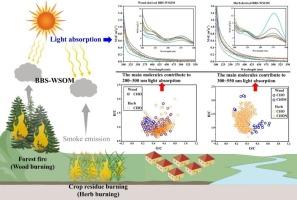生物质燃烧烟气中水溶性有机物分子特征对光吸收变化的新认识
IF 4.4
2区 地球科学
Q1 METEOROLOGY & ATMOSPHERIC SCIENCES
引用次数: 0
摘要
森林火灾(主要是木材燃烧)和作物秸秆燃烧(主要是草本燃烧)是产生生物质燃烧烟雾水溶性有机质(BBS-WSOMs)的两种方式,在很大程度上改变了大气的光吸收。然而,他们的分子特性依赖于光吸收仍然是未知的。因此,本研究将傅里叶变换离子回旋共振质谱(FT-ICR-MS)分析与紫外-可见光谱相结合,深入研究了不同燃烧温度下木源和草药源BBS-WSOMs的不同分子依赖性光吸收。结果表明,在300℃和600℃的燃烧温度下,生物质类型对200 ~ 550 nm光吸收的影响大于燃烧温度。草药源BBS-WSOMs比木源BBS-WSOMs对光的吸收更强。这是因为在草药衍生的bb - wsoms中,更多的共轭二烯结构或更多的低分子质量和高芳香性的CHO化合物负责200-300 nm的光吸收,而更多的CHON化合物(主要是硝基芳烃化合物)负责365-550 nm的光吸收。木源BBS-WSOMs中的CHO/CHOS化合物和草源BBS-WSOMs中的CHON化合物分别负责其在365 ~ 550 nm的光吸收。有趣的是,在220 ~ 275 nm波段,随着波长的增加,含O基团对光吸收的增强作用越来越重要,而在365 ~ 550 nm波段,低O含量的高脂肪族结构对光吸收的增强作用越来越重要。本研究有助于深入了解BBS-WSOMs不同分子依赖的光吸收特性,对大气环境管理和质量控制具有重要意义。本文章由计算机程序翻译,如有差异,请以英文原文为准。

New insights into the molecular characteristics-dependent light absorption variation of water-soluble organic matter in biomass burning smoke
Forest fire (mainly wood burning) and crop residue burning (mainly herb burning) are two ways to produce biomass burning smoke water-soluble organic matters (BBS-WSOMs), largely altering atmospheric light absorption. However, their molecular characteristics-dependent light absorption remains unknown. Hence, this study combined Fourier-transform ion cyclotron resonance mass spectrometry (FT-ICR-MS) analysis with UV–Vis spectrum to deeply investigate the different molecules-dependent light absorption of wood- and herb-derived BBS-WSOMs from different burning temperatures. The results showed that at the tested burning temperatures (300 and 600 °C), biomass types showed a stronger influence on the light absorption at 200–550 nm than burning temperatures. Herb-derived BBS-WSOMs had a stronger light absorption than wood-derived BBS-WSOMs. This was because in herb-derived BBS-WSOMs, more conjugated diene structures or more CHO compounds of low molecular mass and high aromaticity were responsible for their light absorption at 200–300 nm, and more CHON compounds (mainly nitroaromatics compounds) were responsible for their light absorption at 365–550 nm. The CHO/CHOS compounds in wood-derived BBS-WSOMs and CHON compounds in herb-derived BBS-WSOMs were respectively responsible for their light absorption at 365–550 nm. Interestingly, O-containing groups played an increasingly important role in enhancing light absorption with the increasing wavelength at 220–275 nm, while highly aliphatic structure with low O content played an increasingly important role in enhancing light absorption with the increasing wavelength at 365–550 nm. This study is beneficial for deeply understanding the different molecules-dependent light absorption of BBS-WSOMs, having significant implications in atmospheric environment management and quality control.
求助全文
通过发布文献求助,成功后即可免费获取论文全文。
去求助
来源期刊

Atmospheric Research
地学-气象与大气科学
CiteScore
9.40
自引率
10.90%
发文量
460
审稿时长
47 days
期刊介绍:
The journal publishes scientific papers (research papers, review articles, letters and notes) dealing with the part of the atmosphere where meteorological events occur. Attention is given to all processes extending from the earth surface to the tropopause, but special emphasis continues to be devoted to the physics of clouds, mesoscale meteorology and air pollution, i.e. atmospheric aerosols; microphysical processes; cloud dynamics and thermodynamics; numerical simulation, climatology, climate change and weather modification.
 求助内容:
求助内容: 应助结果提醒方式:
应助结果提醒方式:


